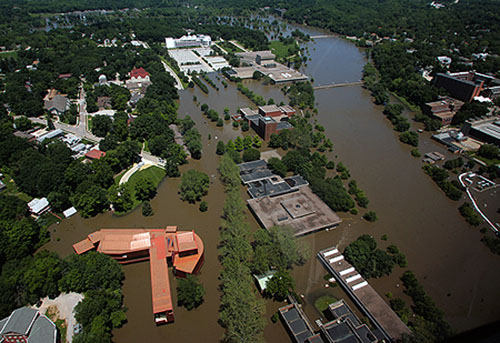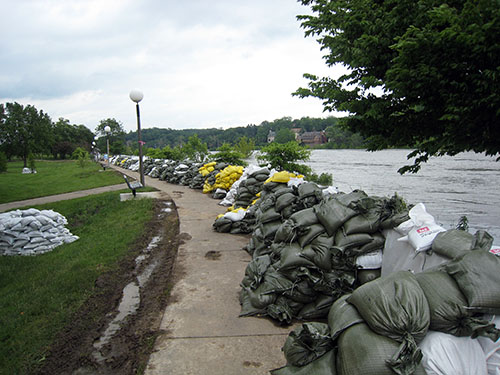The University of the Iowa River
The University of Iowa, Johnson County, Iowa
Emma Husar
2008

Photo Source:http://www.buildings.com/article- details/articleid/6694/title/flood-of-2008-the-university-of-iowa.aspx
Several University of Iowa buildings resided on the banks of the Iowa River—approximately 2.8 million square feet of a 16 million-square-foot campus. In 2008 all of that was in peril as water began to pour over those banks and inundate 20 of the university buildings.
It was the beginning of June, the beginning of the summer term, when water typically flows out of the Coralville Lake created by the Coralville Dam at 6,000 cubic feet per second (cfs). This summer however it hit 39,462 cfs and the water level was five feet over the dam’s emergency spillway. The beginning of summer term was suspended as record-breaking outflow of water rushed into the Iowa River and its surrounding flood plains that coincidentally housed thousands of dorm rooms, a library with countless cherished books, classrooms with technology and other valuable equipment.
Luckily a flood plan had been created in response to the 1993 floods and was put into effect. However, as Don Guckert, associate vice president and director of facilities management at UI, recognizes, “We had a flood plan, it just didn’t anticipate a flood of this magnitude.” On June 15th the river crested at a record of 31.53 feet (a major flood stage crests at 25 feet).

With only two months before 30,000 students would arrive on campus, it was essential to get the imperative buildings—such as the 1,000 bed residence hall, the library, and classrooms—functioning again. Rod Lehnertz, then director of planning, design, and construction at the University of Iowa reminisced on the incredible reconstruction required in these inundated buildings: “You could go into these buildings after they had taken the bottom 4 feet of the walls off, leaving nothing but the steel studs on the concrete floor. You would see dozens of workers with chemical cleaners and toothbrushes, scrubbing the inside and outside corners of every steel stud in the entire building.”
Thanks to those workers, essential buildings were ready three days before students arrived on August 15th, after two months of labor and a cost of approximately $4 million. “The good news” said Guckert: “We’re operational. We brought back half of the space that was idled. The bad news: The other half of the space will take much longer and cost much more because there’s that much more damage.”
As it turned out, those three buildings that were salvaged that same summer were a small fraction of the 20 buildings affected on campus, and the $4 million was an even smaller fraction of the total cost in damages and recovery: $743 million.
